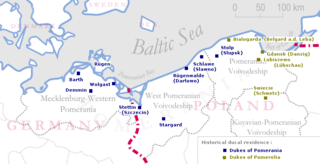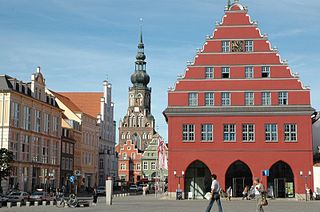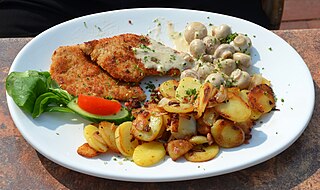
Pomerania is a historical region on the southern shore of the Baltic Sea in Central Europe, split between Poland and Germany. The central and eastern part belongs to the West Pomeranian, Pomeranian and Kuyavian-Pomeranian voivodeships of Poland, while the western part of Pomerania belongs to the German states of Mecklenburg-Western Pomerania and Brandenburg.

Mecklenburg-Vorpommern ; also known by its anglicized name Mecklenburg–Western Pomerania, is a state in the north-east of Germany. Of the country's sixteen states, Mecklenburg-Vorpommern ranks 14th in population; it covers an area of 23,213 km2 (8,963 sq mi), making it the sixth largest German state in area; and it is 16th in population density. Schwerin is the state capital and Rostock is the largest city. Other major cities include Neubrandenburg, Stralsund, Greifswald, Wismar, and Güstrow. It was named after the two regions of Mecklenburg and Vorpommern, and its name means the "nearer part of Pomerania", with the rest now lying in Poland.

Usedom is a Baltic Sea island in Pomerania, divided between Germany and Poland. It is the second largest Pomeranian island after Rügen, and the most populous island in the Baltic Sea.

Greifswald, officially the University and Hanseatic City of Greifswald is the fourth-largest city in the German state of Mecklenburg-Western Pomerania after Rostock, Schwerin and Neubrandenburg. In 2021 it surpassed Stralsund for the first time, and became the largest city in the Pomeranian part of the state. It sits on the River Ryck, at its mouth into the Danish Wiek, a sub-bay of the Bay of Greifswald, which is itself a sub-bay of the Bay of Pomerania of the Baltic Sea.

Swedish Pomerania was a dominion under the Swedish Crown from 1630 to 1815 on what is now the Baltic coast of Germany and Poland. Following the Polish War and the Thirty Years' War, Sweden held extensive control over the lands on the southern Baltic coast, including Pomerania and parts of Livonia and Prussia.

Heringsdorf is a semi-urban municipality and a popular seaside resort on Usedom Island in Western Pomerania, Germany. It is also known by the name Kaiserbad.

Usedom is a town on Usedom Island, in the Vorpommern-Greifswald district in Mecklenburg-Vorpommern, in north-eastern Germany, close to the border with Poland. It is the seat of the Amt Usedom-Süd, to which 14 other communities also belong.

Koserow is a municipality on Usedom Island, in the Vorpommern-Greifswald district, in Mecklenburg-Vorpommern, Germany.

The Principality of Rügen was a Danish principality, formerly a duchy, consisting of the island of Rügen and the adjacent mainland from 1168 until 1325. It was governed by a local dynasty of princes of the Wizlawiden dynasty. For at least part of this period, Rügen was subject to the Holy Roman Empire.

The Pomeranian State Museum in Greifswald, Western Pomerania, is a public museum primarily dedicated to Pomeranian history and arts. The largest exhibitions show archeological findings and artefacts from the Pomerania region and paintings, e.g. of Caspar David Friedrich, a Greifswald local, such as Ruins of Eldena Abbey in the Riesengebirge. The museum was established in the years of 1998 to 2005 at the site of the historical Franziskaner abbey.
Medieval Pomerania was converted from Slavic paganism to Christianity by Otto von Bamberg in 1124 and 1128, and in 1168 by Absalon.

Usedom Abbey was a medieval Premonstratensian monastery on the isle of Usedom near the town of Usedom. It was founded in Grobe and later moved to nearby Pudagla, and is thus also known as Grobe Abbey or Pudagla Abbey respectively.

Groswin was the name-giving seat of one of the castellanies of the Duchy of Pomerania in the High Middle Ages. It was located in Western Pomerania near modern Anklam.

Philipp Julius was duke of Pomerania in the Teilherzogtum Pomerania-Wolgast from 1592 to 1625.

The Angermünde–Stralsund railway is a major railway in the north-eastern German states of Brandenburg and Mecklenburg-Vorpommern, which is part of the long-distance line from Berlin to Rügen. The line is one of the oldest lines in Western Pomerania and was built and operated by the Berlin-Stettin Railway Company from 1863.

Resort architecture is an architectural style that is especially characteristic of spas and seaside resorts on the German Baltic coast. The style evolved since the foundation of Heiligendamm in 1793, and flourished especially around the year 1870, when resorts were connected to big cities via railway lines. Until today, many buildings on the German coasts are built in the style or feature distinct elements of resort architecture.

The Region of Stralsund belonged to the Prussian Province of Pomerania and existed from 1818 to 1932.

Historical Western Pomerania, also called Cispomerania,Fore Pomerania, Front Pomerania or Hither Pomerania, is the western extremity of the historic region of Pomerania forming the southern coast of the Baltic Sea. Western Pomerania's boundaries have changed through the centuries as it belonged to various countries such as Poland, the Duchy of Pomerania, Sweden, Denmark, as well as Prussia which incorporated it as the Province of Pomerania.

Mecklenburg cuisine is typically northeast German. Many dishes in the region today, whilst retaining their original characteristics, frequently add new facets, whilst old dishes are being rediscovered and combined with current recipes.
Erich Gülzow was a German local historian, philologist and publisher. He wrote books on the history of Vorpommern and Rügen island. Through his publications on Ernst Moritz Arndt he became known beyond the borders of Pomerania.






















